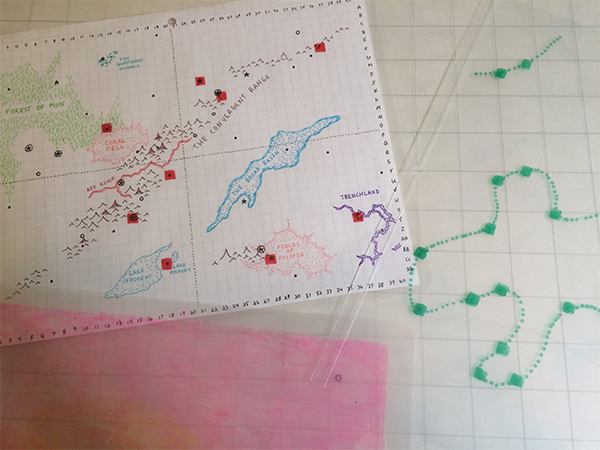A guest article by: Jynx001
My gamer friends and I have a kind of competition going, wherein we try to out-nerd each other with various gimmicks. It started with a pirate’s map burnt onto a piece of leather and eventually escalated to manila folder evidence bags containing NPC dossiers and a custom made USB drive full of world lore and digital game books! When it once again became my turn to run a game, I had to try to reaffirm my place in the game-geek hierarchy by creating some interesting props – and for bonus points: at least one per game session.
The challenge was threefold. First off, we meet weekly – only a handful of hours could be allocated to the creation of props. Secondly, I’m broke – I would have to rely on dollar store finds and my limited collection of office supplies. Thirdly, we were playing Star Wars Saga edition. Any time I could hand over a code cylinder or a vial of alien toxins rather than just describing them, I would try to do so.

I learned how to play and run games in fantasy settings, though I’ve dabbled in Cyberpunk, Shadowrun, and a few modern era campaigns. Staining some copy paper with coffee and cranking out a scroll has and always will be my go-to GM shtick, but they don’t even use paper in a galaxy far, far away. Futuristic is not my forté, and I discovered quickly that I had to look at game props from a different perspective. I had to unlearn what I had learned.
Recycling – A New Hope
If you’re serious about sci-fi props, you need to get serious about recycling. Plastic lids, bottlecaps, cereal box cardstock, and all manner of junk can be converted into computer screens, buttons, custom airspeeders, and scatter terrain. Half the spaceships from the original Star Wars movies were made out of the same stuff, anyway. I had to sort through all my odds and ends and look for potential props.
One of my favorite props was literally a bag of junk. A powerful missile had exploded next to the Imperial Palace and the party was sent to investigate who had tried to assassinate their employer. Searching the crater, they found a collection of bits and pieces that I had assembled from old computer components, bits of wire, bolts from an old couch that had fallen apart years before, and takeout box plastic. To simulate damage, I carefully scorched the disposable bits with a lighter (be careful not to burn or poison yourself with fumes). Some of the scraps had writing on them and when assembled like puzzle pieces and checked over with knowledge skills – gave clues to the culprit.

Transmute Parchment to Plastic
If crumbling maps with slightly burnt edges embody the “feel” of a fantasy setting, then plastic certainly fulfills the same role in a space opera. And a great source of cheap plastic sheets are clear report covers. Searching my local hives of scum and villainy, I discovered packs of six for a dollar. Cut off the spine portion and trim them to the size you need, and you have at least twelve sheets of Star Wars flimsiplast. You can proceed to write on them with various pens or markers, but beware of smudging (put a second sheet on top of the writing) and give your inks plenty of time to dry before handling. Note: certain markers required a second coat to appear evenly.

One of my Star Wars adventures required the party to land on a planet and find the hidden location of a P.O.W. camp. So, on a piece of white cardstock, I drew a large map of the search area with dozens of potential locations labeled. Then, each time they found a clue, they received a clear sheet colored with markers or highlighters. Layering clue-sheets on top of the map and on top of one another, they began to narrow down the choices in the style of a Venn diagram, eventually revealing their target.
Plus, you can use the uncut report covers as intended – covering up a regular sheet of paper and taping around the edge to seal it inside. This could be used for something like the futuristic wanted poster I made for my group of rebels, featuring slightly shopped images of famous people and free-to-download Star Wars fonts.

You and Your “Third” Dimension
Star Wars Saga Edition was one of the early adopters of the “Skill Challenge” concept. The basic idea is that the GM sets up an obstacle (usually not based on combat) and the players come up with ways to use their skills to beat it, If they collectively rack up enough successes, it’s a win. If they fail too often, they go in the Sarlacc pit.
One of my game sessions involved such a challenge – the party had a few days to set up a secret meeting between various diplomats and they were in charge of security. They used their skills to search the planet for a suitable site, knowing that assassins were en route and that they would likely have to defend the location. Then, I broke out the blocks.
My kid has a large set of wooden building blocks, so I borrowed them from his toybox (with permission). Instead of just drawing the map of the place they chose, I built it. Then, for each success they had achieved in the Skill Challenge, I let them change one block – move, remove, substitute, or add. This simulated the extra effort they took to find the perfect location and to improve its defenses. Once they had their 3-D fortress ready, we broke out the miniatures and defended the Alamo (with lasers).

I made two other 3-D maps during the game, which were nice centerpieces during high-stakes adventures. I had imagined the players finding a holographic display of an underground lab, and as they powered up the device, a stack of color-coded floorplans unfurled like a card trick. So I made that with foam core boards, string, and markers, then hung it from the ceiling light fixture in the middle of the room. It took a ridiculous amount of time to get balanced correctly, so I recommend setting aside plenty of extra time for this kind of map.

A slightly easier cartographic creation involved styrofoam spheres and craft wire, which you can find at most hobby stores and some dollar stores. I used three kinds of wire – one was labeled “floral wire”, one was a wire hanger, and another was just the kind of insulated wire that electricians use. The important thing is that the wire is stiff enough to hold its shape after you bend it. Stab the wire into the foam and it should stay put.
On this adventure, the group was infiltrating an old asteroid mining facility that had been converted into a prison run by The Sith. The styrofoam balls represented large chambers and the various wires were either tunnels or ventilation shafts or power conduits, depending on their color. Little scrap pieces of plastic became airlocks.

Oh, and since I had leftover styrofoam spheres, they became alien creatures called Rathtars. I’m only just getting into making my own miniatures. I recommend looking up DMScotty, DMGinfo, Wyloch’s Crafting Vids, and Black Magic Craft on YouTube if you want to see some tutorials on building your own minis and game terrain.

Main Screen Turn On
If you’re one of the lucky few to have upgraded your game space to accommodate the use of a TV screen, computer monitor, or projector – you can enhance your presentations even farther into the future with graphics. Laptops and the like are the most interactive prop possible, and I use these in tandem with Obsidian Portal to show digital maps and NPC portraits whenever feasible. Some of my more technically-minded GM friends have even gone so far as to edit together slideshows and full videos.
One suggestion I would make is that you let your players shoulder some of this prop and presentation work. If you have somebody in your game group who’s good at papercraft or minis, let them build stuff for you. When I saw that running game and managing media was going to be too much to keep track of, I asked one player to run the soundtrack and another to pull up character portraits. Saved me a lot of effort.


